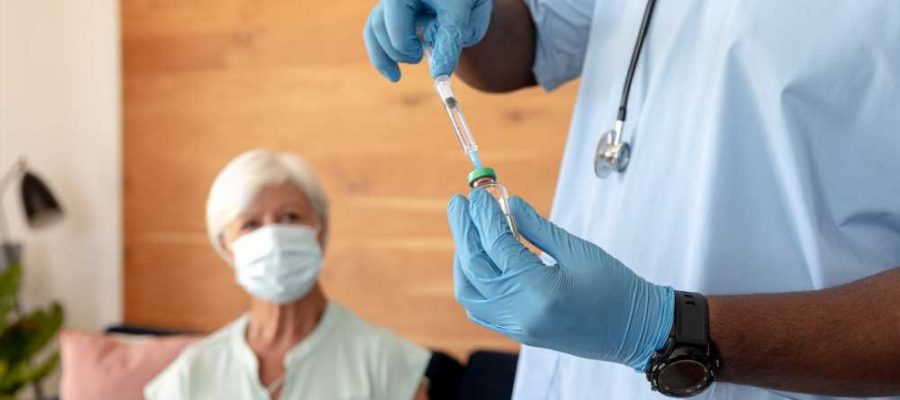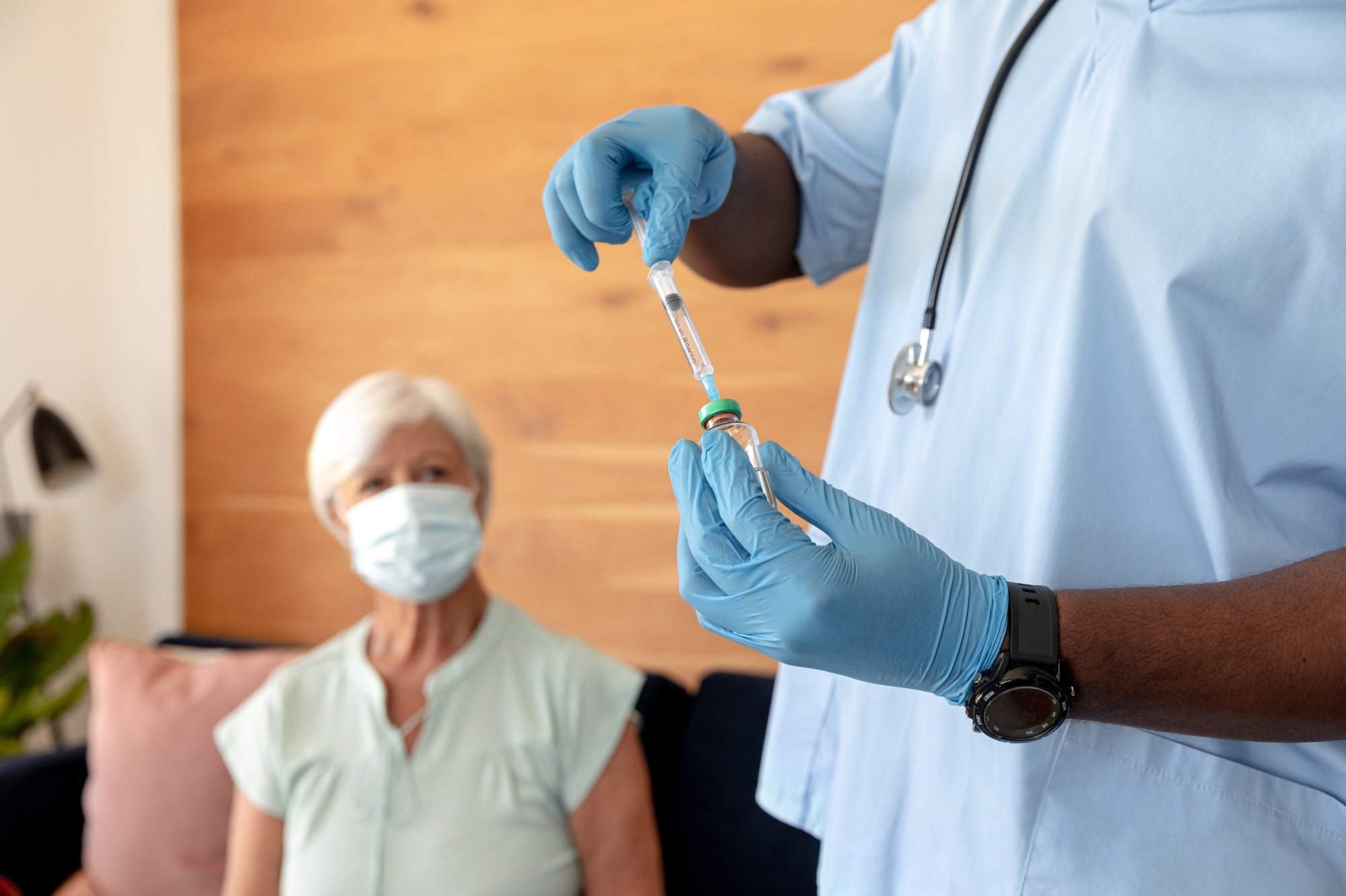
Half-dose Pfizer COVID booster nearly as effective as full dose with fewer side effects
In a recent study published in The Lancet Regional Health Western Pacific, researchers compare the immunogenicity, reactogenicity, and safety of a half-dose Pfizer-BioNTech BNT162b2 coronavirus disease 2019 (COVID-19) booster to a full-dose in adults previously vaccinated with ChAdOx1 (ChAd), BBIBP-CorV (BBIBP), or Gam-COVID-Vac.
 Study: Immunogenicity, safety, and reactogenicity of a half- versus full-dose BNT162b2 (Pfizer-BioNTech) booster following a two-dose ChAdOx1 nCoV-19, BBIBP-CorV, or Gam-COVID-Vac priming schedule in Mongolia: a randomised, controlled, non-inferiority trial. Image Credit: wavebreakmedia / Shutterstock.com
Study: Immunogenicity, safety, and reactogenicity of a half- versus full-dose BNT162b2 (Pfizer-BioNTech) booster following a two-dose ChAdOx1 nCoV-19, BBIBP-CorV, or Gam-COVID-Vac priming schedule in Mongolia: a randomised, controlled, non-inferiority trial. Image Credit: wavebreakmedia / Shutterstock.com
Background
As COVID-19 vaccine effectiveness diminishes over time due to waning immunity and emerging viral variants, booster doses have become crucial, particularly for highly vulnerable patient populations. Countries are increasingly administering third and fourth booster shots, often using the BNT162b2 vaccine.
Heterologous boosting with BNT162b2 has shown higher immunogenicity but greater reactogenicity as compared to homologous boosting in individuals initially vaccinated with vaccines like ChAd, BBIBP, or CoronaVac. Fractional dosing, a strategy used successfully in other diseases, is being considered for boosting, given its potential to reduce reactogenicity and costs, as well as increase vaccine acceptance and resilience against supply disruptions.
However, data is limited on the effectiveness and reactogenicity of fractional BNT booster doses in diverse populations, especially those vaccinated with vaccines like BBIBP or Gam-COVID-Vac, which are commonly used in low- and middle-income countries; therefore, further research is essential.
About the study
The most recent phase III study conducted in Mongolia examined the effects of a half-dose (15 μg) versus a full-dose (30 μg) of the BNT162b2 COVID-19 booster vaccine in adults previously immunized with two doses of either ChAd, BBIBP, or Gam-COVID-Vac. This study was ethically approved and sought to monitor subjects for one year, concentrating on the initial 28-day period.
Adults who had taken their first dose of vaccines for more than six months in different health centers and organizations were included in the current study. For inclusion criteria, all study participants offered written informed consent.
Stratified according to the vaccine type and participant’s age, patients were randomly distributed into half- or full-dose groups. Participants and those in charge of evaluating reactogenicity remained unaware of group assignments until day 28.
A baseline assessment was performed for each participant, followed by the collection of blood samples, after which participants were administered their respective booster doses. Study participants were observed for immediate reactions and were provided with instruments to monitor reactogenicity over a period of one week. Blood samples and health assessments were subsequently performed on days one, seven, and 28.
The primary outcomes of the investigation included seroresponse rate and reactogenicity within 28 days after boosting. Seroresponses were determined based on specific anti-spike immunoglobulin G (IgG) levels, whereas reactogenicity was assessed by the severity of reactions. Secondary endpoints included the comparison of geometric means of antibody levels, and any reported adverse effects.
Statistical analysis, conducted using the Estimand Framework, considered both primary and secondary endpoints, with adjustments for various covariates, and was performed using Stata software.
Study findings
Between May and September 2022, 300 participants received a full 30 µg dose, and 301 received a half 15 µg booster dose. The median age of the study cohort was 44 years, with about 40% exceeding at least 50 years of age, which is representative of the Mongolian population. The median interval between the second and third doses was 428 days.
Individuals who received the half-dose reported fewer local and systemic reactions as compared to the full-dose group. Specifically, there were fewer cases of pain, tenderness, fever, vomiting, diarrhea, headache, fatigue, joint pain, and muscle pain. Grade three and four reactions within seven days following vaccination were low in both groups.
In terms of immunogenicity, 84.7% and 86.6% of the half-dose and full-dose recipients exhibited a seroresponse, respectively. The percentage difference in seroresponse between the half- and full-dose groups was within the acceptable range, thus indicating non-inferiority. However, the response was slightly lower in the half-dose group among Gam-primed participants.
The geometric mean ratio (GMR) of day 28 anti-spike IgG levels between the half- and full-dose groups was 0.94 overall. This was similar for ChAd- and BBIBP-primed participants but lower for Gam-primed participants in the half-dose arm. This pattern persisted across different age and body mass index (BMI) groups.
Exploratory analysis showed a greater response to the booster dose in individuals with lower baseline IgG levels, which was especially pronounced in Gam-primed half-dose recipients. Neutralizing antibody levels against the Wuhan-Hu-1 viral variant were high pre- and post-boosting in both dose groups and across all priming schedules. A similar increase was observed for neutralizing antibodies against the Omicron B.1.1.529 variant after boosting.
Adverse events (AEs) and serious adverse events (SAEs) were comparable across both groups, with none of the SAEs related to the study vaccine. There were no differences in the frequency, severity, or duration of AEs between the study arms.
- Batmunkh, T., Moore, K. A., Thomson, H., et al. (2023). Immunogenicity, safety, and reactogenicity of a half- versus full-dose BNT162b2 (Pfizer-BioNTech) booster following a two-dose ChAdOx1 nCoV-19, BBIBP-CorV, or Gam-COVID-Vac priming schedule in Mongolia: a randomised, controlled, non-inferiority trial. The Lancet Regional Health Western Pacific. doi:10.1016/j.lanwpc.2023.100953
Posted in: Medical Research News | Disease/Infection News | Pharmaceutical News
Tags: Antibodies, Antibody, Blood, Body Mass Index, Coronavirus, Coronavirus Disease COVID-19, covid-19, Diarrhea, Efficacy, Fatigue, Fever, Frequency, Headache, Homologous, immunity, Immunoglobulin, Joint Pain, Muscle, Omicron, Pain, Research, SARS-CoV-2, Software, Vaccine, Vomiting

Written by
Vijay Kumar Malesu
Vijay holds a Ph.D. in Biotechnology and possesses a deep passion for microbiology. His academic journey has allowed him to delve deeper into understanding the intricate world of microorganisms. Through his research and studies, he has gained expertise in various aspects of microbiology, which includes microbial genetics, microbial physiology, and microbial ecology. Vijay has six years of scientific research experience at renowned research institutes such as the Indian Council for Agricultural Research and KIIT University. He has worked on diverse projects in microbiology, biopolymers, and drug delivery. His contributions to these areas have provided him with a comprehensive understanding of the subject matter and the ability to tackle complex research challenges.